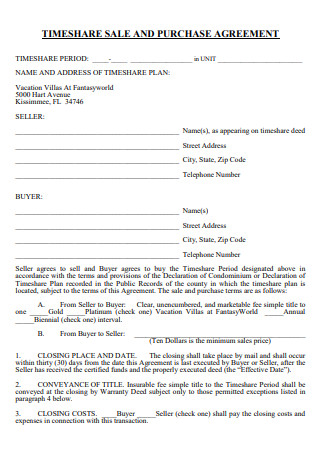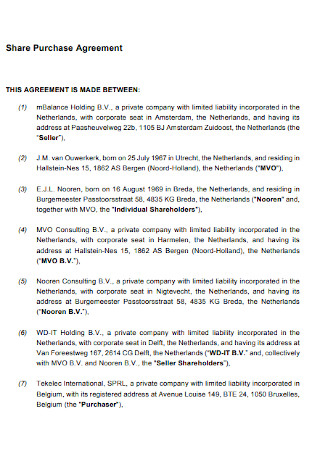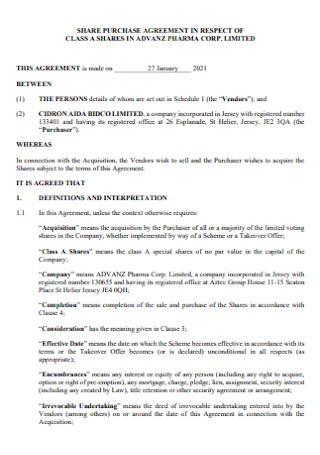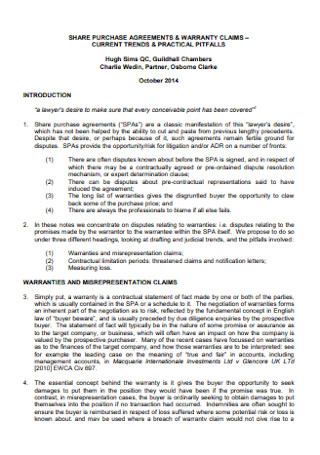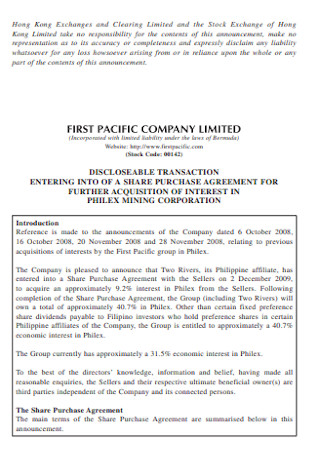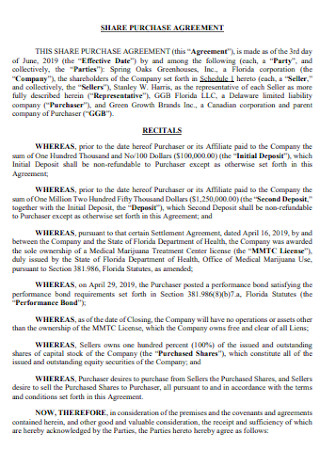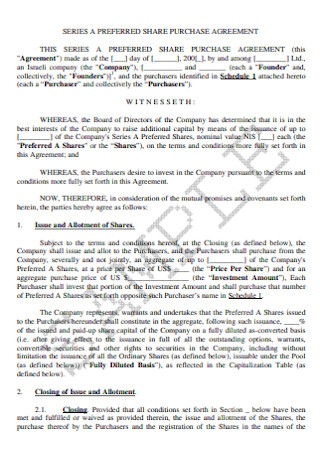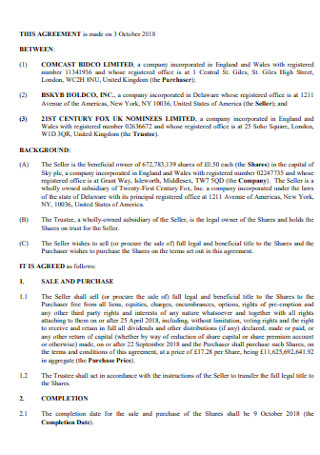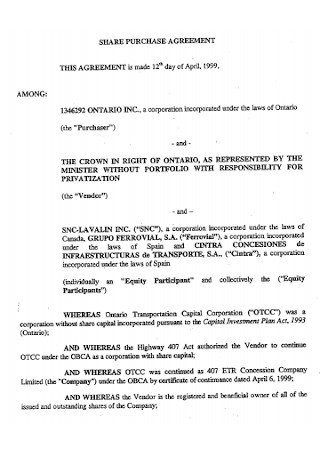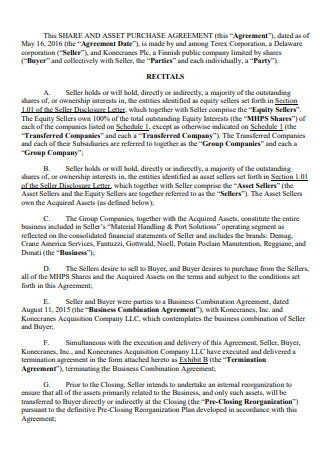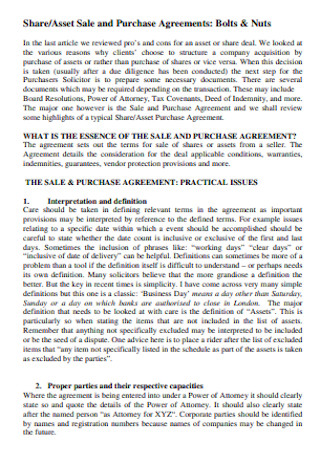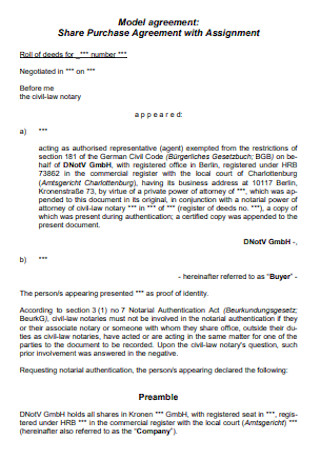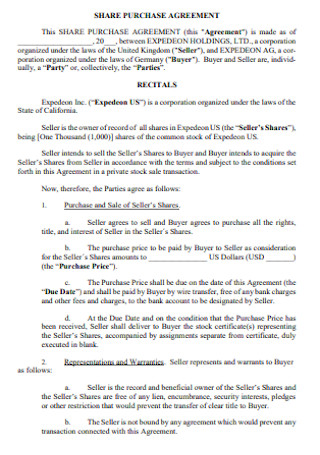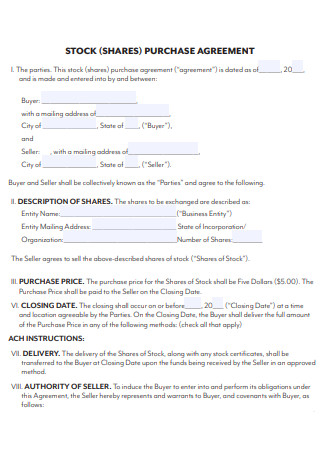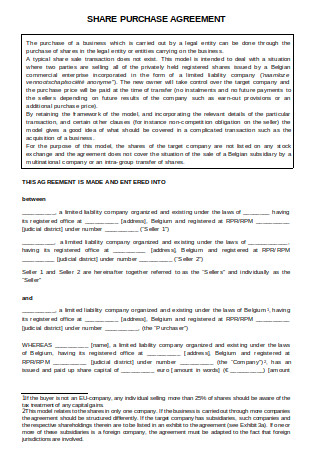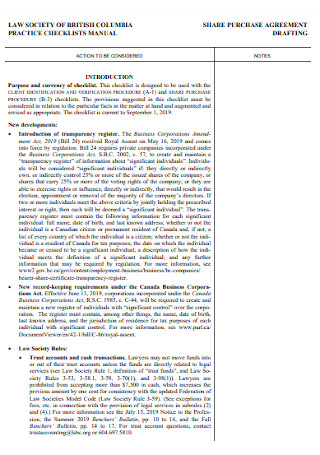15+ Sample Share Purchase Agreements
FREE Share Purchase Agreement s to Download
What Is a Share Purchase Agreement?
A share purchase agreement is a binding and legal document between two parties that results in a transaction between the buyer and seller. The agreement sets the terms and conditions related to the sale and purchase of shares in an organization. The seller of the shares agrees to market shares for a specified amount. The document aims to prove that the arrangement between both parties follows a mutual agreement. The share purchase agreement specifies considerations and the number of shares up for sale, preceding conditions, and specific covenants classified by the buyer and seller. After signing, the seller defines the allocation of shares to the buyer. The share purchase agreement is a business practice in terms of initiating shareholders into the organization. With the absence of the document, complications and problems may arise.
By definition, market shares refer to the percentage of an industry or the market’s total sales as revenue over a specified period. Calculating market share is the company’s total market sales per period divided by the sum of sales of the specific industry. According to the economic statistical data by Statista, one of the largest companies in the world, Coca-Cola, has a market share of 44.9 percent in the United States, followed by Pepsico with a 25.9 percent market share.
Components of a Share Purchase Agreement
With it being a vital document in any business or organization, a share purchase agreement must hold comprehensive elements that set terms and conditions agreed upon by the parties. Aside from that, necessary provisions must also be present in the document. Below are the components that complete a share purchase agreement to guarantee the safety of the parties.
Details of the parties: The share purchase agreement must indicate the involved parties of the negotiation. Mention the seller and the buyer and the corresponding information about them. At times, the parties are shell-holding companies for the share purchase agreement only.Definitions: These are meanings of words that attributes to specific items on the agreement. It can have precise or alternate definitions that are present in the industry that carries the document. For words bringing confusion, ambiguity, difficulty, or lengthy must be present in this section. Indicating recurring words, phrases, or concepts serves helpful to the individual reading the agreement. These words are often within quotation marks, in bold letters, and with a capital letter to identify it is the defined term.Sales and purchase of sales: The section is one of the key components of a SPA or a sales purchase agreement. It specifies the total number of shares for acquisition, including the rights, titles, and accompanying interests from the shares by the buyer. The purchase price, payment schedule, and method are also present in this section of the agreement. It also dictates the place and time for closing the transaction. The section also specifies if the signing and closing of the agreement will be simultaneous or deferred. Deferred closing happens when there is a gap between the implementation or transfer of shares from the finality of the agreement. These instances happen for various reasons, including regulatory approvals and third-party consents in terms of financing. Purchase price adjustment and earn-outs: Purchase price adjustments help secure the buyer from drastic changes in the shares’ value during the agreement’s duration. Valuation methods and accounting policies must come from a mutual understanding between two parties to prevent price inflation. On the other hand, earn-outs are contingency payments to satisfy particular milestones for future performances within a specific timeframe. These help mitigate risk acquisitions from the buyer and a relatively better price if the shares achieve their objectives. Earn-outs can also be financial or non-financial that helps in dispute management. In short, earn-outs are additional payments for achieving agreed purchase turnouts.Escrow: The share purchase agreement also has an escrow section that states a third-party entity holds and is responsible for the shares in the agreement until the closing. These are advantageous when earn-outs, purchase price adjustments, and holdouts are in place. The escrow is on a separate agreement and must undergo careful drafting, determining the payment or withholding of funds.Material adverse effect: Material adverse effect (MAE) determines the threshold for negative incidents affecting the business. A buyer will stress their protection severe changes happen to the business during the SPA’s execution. MAEs qualify the validity of presentations, warranties, and covenants in the agreement. The entirety of the section depends on the nature of the transaction, industry, and negotiating capacities of the parties.Conditions precedent: Commonly addressed as closing conditions are shared stipulations that must be satisfied or waived before the agreement’s finality. The failure to satisfy these conditions gives the other party rights to discontinue the transaction with suffering liabilities. In instances of deferred closing, events manifest after the SPA’s execution, with one party terminating it before closing. The conditions precedent follows a specific transaction, addressing the parties’ needs and circumstances. The common statements present in the SPA include bring-downs of representations and warranties, approvals, denying legal impediments, document delivery, payments, disencumbrance, consents, compliance, MAE, litigations, and legal opinions.Representations and warranties: A mutual exchange of representations and warranties by both parties discloses relevant information to one another. A seller’s representation can be lengthy compared to a buyer’s since it details the target company, its business, assets, and liabilities. In turn, it favors the seller in terms of negotiations and the nature of transactions. It sets risk allocation between parties by creating a basis for legal claims from breach of contract or misrepresentation. A seller’s representations and warranties cover that a target legally exists, is complete and accurate, without undisclosed liabilities, has properly filed tax returns, and has adequate insurance, among others. For purchasers, broad and absolute representations and warranties give a firm ground for termination or indemnification process. The purchaser’s representations and warranties involve their organization, power, and standing, compliance with applicable laws, and legality of funds, among others.Indemnification: The indemnification clause addresses liability of incurred losses due to misrepresentations and breaches. It is a remedy to assert particular claims. It specifies the process and payment of claims. including the limitations or qualifications to issue them. In some cases, it includes the creation of a waiver available and applicable under certain stipulations. A materiality scrape is a provision in the indemnification clause favoring the purchaser. It states that in determining the validity of a representation or warranty when calculating for losses because of a breach, the materiality and knowledge identifiers of the seller are null and void.Pre-closing covenants: This section limits the seller’s capacity before the deal closes. The conditions set by the seller outweighs the buyer as they remain in control of the shares until closing. These are commonly seen in deferred closings to protect and preserve the value of assets. It ensures the parties give their best efforts to close the transaction and includes the buyer’s right to access books and records and requirements to transform the company to accommodate the transaction. It also prohibits the seller from issuing new shares, transferring shares to another entity, incurring new debts, granting security interests, entering into mergers, acquisitions, or joint ventures, and making material changes to the company, among others.Termination rights: The termination right permits any of the parties to end the SPA before closing. The termination can be through a written notice, breach of contract, failure to satisfy conditions, and legal and statutory provisions.Ancillary documents and agreements: Ancillary documents and agreements comprise scheduled appendices that parties must provide before the closing of the agreement and includes non-disclosure, non-solicitation, and non-compete agreements, board minutes and resolutions, loan notes, escrow deeds, contributions deeds, and shareholder agreements.Post-closing covenants: The post-closing covenants apply once a transaction is complete and follows the parties’ needs. They ensure that the buyer maintains tax and business records and maintains insurance for outgoing officers. It also prevents the seller from competing with the company and from soliciting new hires.Confidentiality and non-disclosure: Any non-disclosure agreement language within the share purchase agreement reflects additions to the prior NDA as a reference, and any language not present, supersedes it. It must also contain restrictive language concerning press communications. Sellers will also demand a broad definition regarding confidential information to secure proprietary information.Miscellaneous provisions: These are essential components to any agreement and are a space where lawyers cache terms that tend to be overlooked. It includes how notices are sent, severability of unenforceable terms, persisting provisions after closing, dispute resolution methods, amendment processes, cost allocation for disputes, among others. Choice of law and forum selection: The section specifies the contractual terms regulating the agreement. The choice-of-law clause determines the law of specific jurisdiction to govern the share purchase agreement and identifies the issues regarding rights and obligations. The section also specifies the adjudication process for disputes. A dispute resolution clause also specifies the governing law, seat of adjudication, and the forum location. It is through the arbitration statement that parties select the governing law, determine the arbitration body in adjudicating disputes, and arbitration rules governing the dispute.
How to Draft a Share Purchase Agreement
Recognizing the necessary elements in a share purchase agreement is critical to creating a well-written document. As the agreement is a legal document, its construction must cover all the necessary components. Below are helpful steps that you can do to create your share purchase agreement.
Step 1: Properly Format Your Share Purchase Agreement
Start by typing in the document through a word processing program. Use an easily readable font style to ensure that your readers comprehend the text. Indicate a distinct title on your agreement, setting it on the top and center of the first page. Emphasize the title by having it in capital letters or a Chicago-style title. Identify the involved parties at the beginning of your agreement and include the date of the arrangement. Write out the recitals, summarizing the reason for engagement of the buyer and seller. It helps clarify the initial purpose of the arrangement.
Step 2: Explain the Terms of Sale
Continue with the purchase agreement by indicating the shareholder granting the shares to the buyer. You also have the option to create a price list per share and an aggregate amount for a given number of shares. Indicate a provision that the buyer must deliver the agreed amount in the agreement. It is advisable to consult with a lawyer during the document’s drafting. Afterward, explain the process of delivering the shares to the buyer.
Step 3: Identify the Necessary Warranties
Write up a warrant that states you are under the authority to sell shares from a particular company. In return, the share purchase agreement must indicate the authority of the buyer to make the purchase. Include a provision stating that the shares are free and clear from any liens clouding title. It is advisable to cite investment risks to protect yourself and the buyer. Include a statement where the buyer and seller warrant not to expose any transaction records in cases of lawsuits.
Step 4: Finalize Your Document
Ensure that you have a merger clause intact, indicating all arrangements made between the parties. It helps prevent either party from claiming prior settlements as valid. A severability clause prevents a court of law from voiding an agreement if some provisions are illegal. Also, indicate a governing law that covers the agreement that helps settle court disputes. For changes or adjustments in the agreement, indicate that any revisions must be in a written document. Lastly, insert signature spaces where both parties must sign to close the deal.
FAQs
When do you need a share purchase agreement?
A share purchase agreement is mandatory if a business or an individual is purchasing or selling a particular number of shares within the company to another person or organization. For example, two business partners with equal shares must have a share purchase agreement when one chooses to leave and sell their share of the company. In the event of selling all shares in an organization, a purchase of a business agreement is used.
Who should write the draft of the share purchase agreement?
In terms of shares between two parties, the draft of the share purchase agreement is the buyer’s responsibility through the help of their legal representatives because the agreement greatly influences the buyer, and it is the goal of the SPA to protect them against any liabilities afterward. If the shares are in an auction, it is the seller’s responsibility to draft the share purchase agreement, and it is available to any party planning to purchase.
What is the difference between a shareholder’s agreement and a share purchase agreement?
The main difference between the two is that a shareholder’s agreement describes the rights and obligations of the organization and its shareholders. Meanwhile, the SPA is an agreement for the transfer of shares from the seller to the purchaser.
If an individual wants to sell or purchase a portion of shares at a company, a share purchase agreement is an essential document you want in your arsenal. It gives you the right to due diligence to ensure that deal will bring no issues by the end of the transaction. Having the document also guarantees that the rights of both parties are upheld and fair to one another. Start making your share purchase agreement for future transactions by using and downloading the share purchase agreement samples available above.
